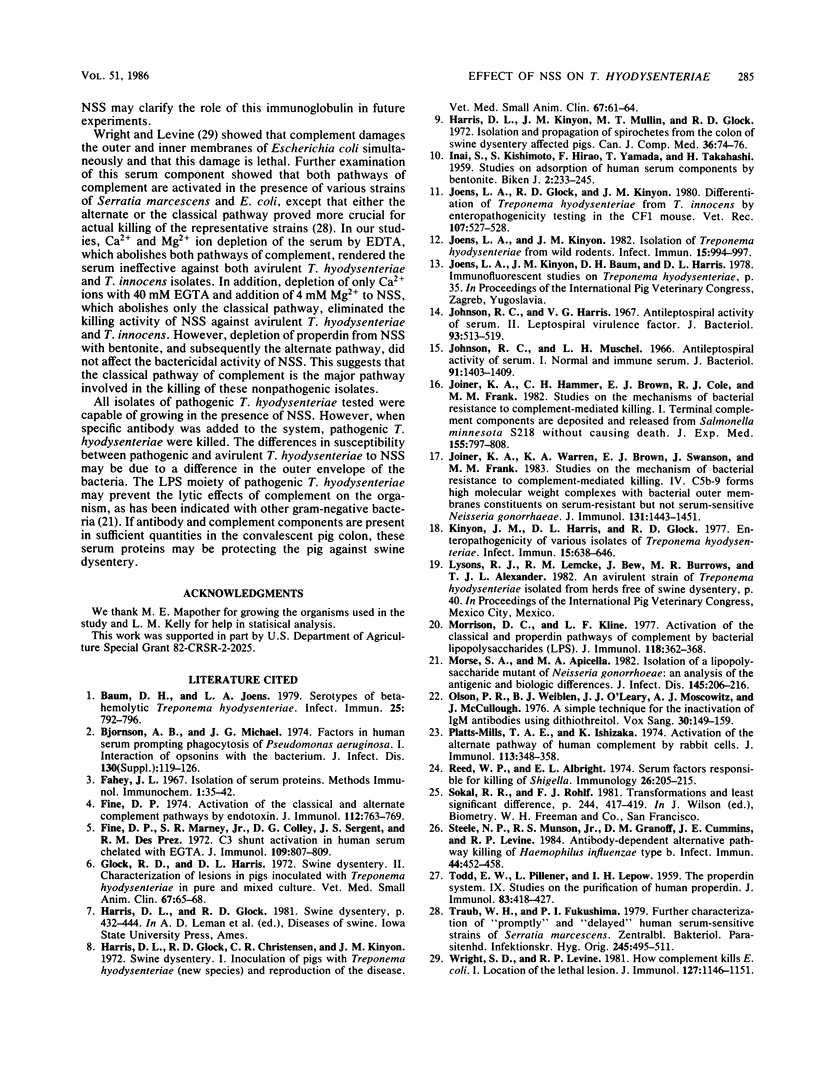Abstract
Treponema hyodysenteriae was incubated in 20% normal swine sera (NSS) at 37 degrees C for 4 h, and viability was determined by a plate dilution method. NSS was bactericidal for nonpathogenic T. innocens and avirulent T. hyodysenteriae, but not for virulent T. hyodysenteriae isolates. Heat inactivation at 56 degrees C for 30 min, treatment with EDTA or EGTA [ethylene glycol-bis(beta-aminoethyl ether)-N,N-tetraacetic acid], or removal of immunoglobulin M eliminated the bactericidal activity of NSS. However, removal of the alternate complement pathway with 10 mg of bentonite per ml did not remove bactericidal activity of NSS. Incubation of virulent isolates of T. hyodysenteriae in the presence of specific antisera plus NSS resulted in bactericidal activity. These data suggest that complement and natural antibody may be involved in protecting the host from T. innocens or avirulent T. hyodysenteriae and that T. hyodysenteriae antibody plus complement are involved in protecting convalescent pigs from re-exposure to swine dysentery.
Full text
PDF



Selected References
These references are in PubMed. This may not be the complete list of references from this article.
- Baum D. H., Joens L. A. Serotypes of beta-hemolytic Treponema hyodysenteriae. Infect Immun. 1979 Sep;25(3):792–796. doi: 10.1128/iai.25.3.792-796.1979. [DOI] [PMC free article] [PubMed] [Google Scholar]
- Fine D. P. Activation of the classic and alternate complement pathways by endotoxin. J Immunol. 1974 Feb;112(2):763–769. [PubMed] [Google Scholar]
- Fine D. P., Marney S. R., Jr, Colley D. G., Sergent J. S., Des Prez R. M. C3 shunt activation in human serum chelated with EGTA. J Immunol. 1972 Oct;109(4):807–809. [PubMed] [Google Scholar]
- Glock R. D., Harris D. L. Swine dysentery. II. Characterization of lesions in pigs inoculated with Treponema hyodysenteriae in pure and mixed culture. Vet Med Small Anim Clin. 1972 Jan;67(1):65–68. [PubMed] [Google Scholar]
- Harris D. L., Glock R. D., Christensen C. R., Kinyon J. M. Inoculation of pigs with Treponema hyodysenteriae (new species) and reproduction f the disease. Vet Med Small Anim Clin. 1972 Jan;67(1):61–64. [PubMed] [Google Scholar]
- Harris D. L., Kinyon J. M., Mullin M. T., Glock R. D. Isolation and propagation of spirochetes from the colon of swine dysentery affected pigs. Can J Comp Med. 1972 Jan;36(1):74–76. [PMC free article] [PubMed] [Google Scholar]
- Joens L. A., Glock R. D., Kinyon J. M. Differentiation of Treponema hyodysenteriae from T innocens by enteropathogenicity testing in the CF1 mouse. Vet Rec. 1980 Dec 6;107(23):527–529. [PubMed] [Google Scholar]
- Joens L. A., Kinyon J. M. Isolation of Treponema hyodysenteriae from wild rodents. J Clin Microbiol. 1982 Jun;15(6):994–997. doi: 10.1128/jcm.15.6.994-997.1982. [DOI] [PMC free article] [PubMed] [Google Scholar]
- Johnson R. C., Harris V. G. Antileptospiral activity of serum. II. Leptospiral virulence factor. J Bacteriol. 1967 Feb;93(2):513–519. doi: 10.1128/jb.93.2.513-519.1967. [DOI] [PMC free article] [PubMed] [Google Scholar]
- Johnson R. C., Muschel L. H. Antileptospiral activity of serum. I. Normal and immune serum. J Bacteriol. 1966 Apr;91(4):1403–1409. doi: 10.1128/jb.91.4.1403-1409.1966. [DOI] [PMC free article] [PubMed] [Google Scholar]
- Joiner K. A., Hammer C. H., Brown E. J., Cole R. J., Frank M. M. Studies on the mechanism of bacterial resistance to complement-mediated killing. I. Terminal complement components are deposited and released from Salmonella minnesota S218 without causing bacterial death. J Exp Med. 1982 Mar 1;155(3):797–808. doi: 10.1084/jem.155.3.797. [DOI] [PMC free article] [PubMed] [Google Scholar]
- Joiner K. A., Warren K. A., Brown E. J., Swanson J., Frank M. M. Studies on the mechanism of bacterial resistance to complement-mediated killing. IV. C5b-9 forms high molecular weight complexes with bacterial outer membrane constituents on serum-resistant but not on serum-sensitive Neisseria gonorrhoeae. J Immunol. 1983 Sep;131(3):1443–1451. [PubMed] [Google Scholar]
- Kinyon J. M., Harris D. L., Glock R. D. Enteropathogenicity of various isolates of Treponema hyodysenteriae. Infect Immun. 1977 Feb;15(2):638–646. doi: 10.1128/iai.15.2.638-646.1977. [DOI] [PMC free article] [PubMed] [Google Scholar]
- McGowan J. E., Jr, Klein J. O., Bratton L., Barnes M. W., Finland M. Meningitis and bacteremia due to Haemophilus influenzae: occurrence and mortality at Boston City Hospital in 12 selected years, 1935-1972. J Infect Dis. 1974 Aug;130(2):119–124. doi: 10.1093/infdis/130.2.119. [DOI] [PubMed] [Google Scholar]
- Morrison D. C., Kline L. F. Activation of the classical and properdin pathways of complement by bacterial lipopolysaccharides (LPS). J Immunol. 1977 Jan;118(1):362–368. [PubMed] [Google Scholar]
- Morse S. A., Apicella M. A. Isolation of a lipopolysaccharide mutant of Neisseria gonorrhoeae: an analysis of the antigenic and biologic difference. J Infect Dis. 1982 Feb;145(2):206–216. doi: 10.1093/infdis/145.2.206. [DOI] [PubMed] [Google Scholar]
- Olson P. R., Weiblen B. J., O'Leary J. J., Moscowitz A. J., McCullough J. A simple technique for the inactivation of IgM antibodies using dithiothreitol. Vox Sang. 1976;30(2):149–159. doi: 10.1111/j.1423-0410.1976.tb02806.x. [DOI] [PubMed] [Google Scholar]
- Platts-Mills T. A., Ishizaka K. Activation of the alternate pathway of human complements by rabbit cells. J Immunol. 1974 Jul;113(1):348–358. [PubMed] [Google Scholar]
- Reed W. P., Albright E. L. Serum factors responsible for killing of Shigella. Immunology. 1974 Jan;26(1):205–215. [PMC free article] [PubMed] [Google Scholar]
- Steele N. P., Munson R. S., Jr, Granoff D. M., Cummins J. E., Levine R. P. Antibody-dependent alternative pathway killing of Haemophilus influenzae type b. Infect Immun. 1984 May;44(2):452–458. doi: 10.1128/iai.44.2.452-458.1984. [DOI] [PMC free article] [PubMed] [Google Scholar]
- TODD E. W., PILLEMER L., LEPOW I. H. The properdin system and immunity. IX. Studies on the purification of human properdin. J Immunol. 1959 Oct;83:418–427. [PubMed] [Google Scholar]
- Traub W. H., Fukushima P. I. Further characterization of "promptly" and "delayed" human serum-sensitive strains of Serratia marcescens. Zentralbl Bakteriol Orig A. 1979 Dec;245(4):495–511. [PubMed] [Google Scholar]
- Wright S. D., Levine R. P. How complement kills E. coli. I. Location of the lethal lesion. J Immunol. 1981 Sep;127(3):1146–1151. [PubMed] [Google Scholar]


